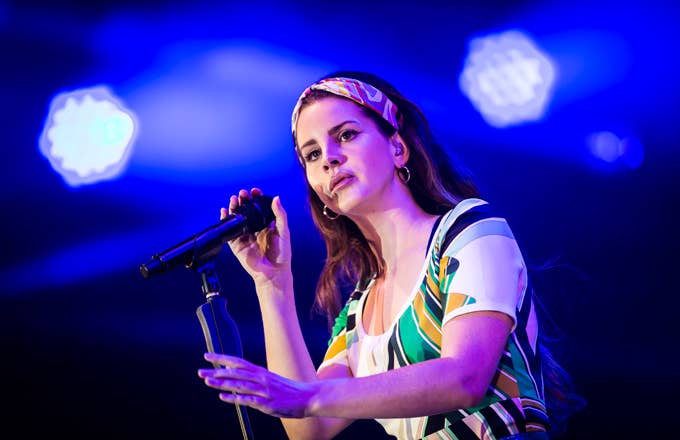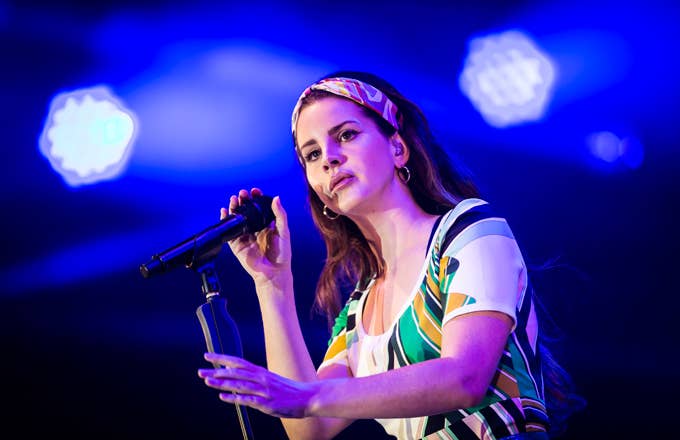
The true story of Lana Del Rey’s rise and reveal has so long circulated that even it borders on myth. She emerged with a vacant smolder and haunting lilt on the self-directed “Video Games,” which promptly went viral. It was 2011, when music bloggers were alive and well and there indie-purists to squabble over the Americana aesthetics of it all. Then, the spell was unceremoniously broken by the discovery of an all-American girl named Lizzy Grant. Lizzy Grant was born Elizabeth Woolridge Grant. Lizzy Grant is the daughter of two Manhattanites. Lizzy Grant went to boarding school. Lizzy Grant is alsoMail Jailer. The accusations came soon after: Lana Del Rey’s past as Lizzy Grant meant to many that she was a fraud. Suddenly, no matter the affinity for her sound, the then-26-year-old artist became embroiled in a commentary over authenticity and image-making that might chase her entire career. “Audiences felt duped and sought to punish her for their own suspensions of disbelief,” author Alana Massey writes in her recent book All the Lives I Want. “Lana was accused of pornifying authentic Hollywood glamour.”
Virtually nothing at the surface of Lana del Rey screams thug life. And for an artist like Lana, surface means so much. She is less otherworldly than ourworldly, a summation of our national dreams and cultural appetites who puts her money where her mouth is. Since the “Video Games” days, Lana has been associated with aesthetics that seemingly leave little room for black people: a filtered smattering of numerous Californian beforetimes, when black cool was hip but safely distilled through the likes of Elvis Presley and John Lennon (the former literally takes center stage in Del Rey’s short film Tropico). Despite a look that is as much in conversation with Dorothy Dandridge and Eartha Kitt as Marilyn Monroe and Cher, audiences and critics have mostly been content to take Lana’s surface at face value and only so—nostalgic, filtered, feminine, white.
Her sound, however, has long been the product of an artist who doesn't shy from working with black genres. Interviews peel back a fondness for Billie Holiday, Nina Simone ( Del Rey covered Simone’s iconic renditions of “The Other Woman” and “Don’t Let Me Be Misunderstood” on Ultraviolence and Honeymoon, respectively), Miles Davis, and 50 Cent, alongside more predictable influences like Bob Seger, the Eagles, and Nirvana. She worked closely with producer Emile Haynie (Eminem, Kid Cudi, Kanye West), as well as Jeff Bhasker (Kanye West, Jay-Z, Beyoncé) for her official Lana Del Rey debut, 2012’s Born to Die, an album so suffused with trip-hop and trap beats, rapped cadences, and black vernacular that hip-hop must be known as much more than a casual influence in Lana’s sonic personality. Her allegiance to those earlier minimalist beats has waned (Ultraviolence) and waxed (Honeymoon) across projects, but her vernacular ever remains indebted to black cool.
For some, Lana’s diverse sources circle back into further proof of her inauthenticity—The New Yorker’s Sasha Frere-Jones claimed she didn’t “have the emotional and psychological depth to support all the satin and spotlights” of a Kanye-esque production in 2012. And many of Lana’s attempts to incorporate language and styles from people of color haven’t been such a great look. Her self-given monikers like “gangsta Nancy Sinatra” and “Lolita got lost in the hood” sound like something a much lazier pop star might have come up with; her dip into Latina homegirl aesthetics in Tropicodid not work; she has used the word “ghetto” a little too freely. Still, Lana has a street cred that makes her an attractive collaborator for artists like the Weeknd and ASAP Rocky, and vice-versa.
On her latest album Lust for Life, the artist prone to going featureless recruits both in addition to Atlanta adlib artist Playboi Carti. Presumably by design, their songs have been chosen as promotional releases ahead of the album: “Lust for Life,” featuring the Weeknd, “Summer Bummer,” featuring Rocky and Carti, and “Groupie Love,” featuring Rocky.
Lana and current hip-hop culture (in the broadest sense) aren’t the oil and water mixture they might seem at surface-level, though there’s plenty of superficial reasons why the two would find each other’s company. They idolize the same gods and relics from a bygone gangsta glamour. Both more than dabble with themes of wealth, drugs, and depression in low times along with money, sex, and weed when they’re up (and also down). Christian allusions are inescapable. Internet nativism is highly favored despite homages to the old school. Dressed in “don’t get out of bed for less than” satin gowns, wearing pearls and acrylics, with teased and burgundy-stained tresses, Lana blasphemes the respectability of old money silhouettes with gaudy, new money ones—an irreverent fusion perfected by rappers before she finished grade school and kept alive most popularly by Kanye and Jay in works like My Beautiful Dark Twisted Fantasy and Watch the Throne (West is an admirer of Del Rey’s and she sang at his and Kim’s wedding).
However, there are also other, more substantials affinities to explain her relation to the genre(s). While defenses of Lana Del Rey’s choice to embody a chosen persona has been compared to the likes of pop music fiction, no other category of music could better understand the freedom found in a persona like rap music. An unflattering review of Lana’s Born to Die in the New York Times described her image as “a pose,” a word that emphasizes the performative quality of her artistry, as someone whose postures are for the benefit of peers and audiences rather than a true reflection of an inner self. “Posed” has been a criticism lobbed at rappers for decades now, attached to critiques of hip hop culture as vapid and materialistic, obsessed with looks over character. Nevermind that rap has been a form of alternative world building since the beginning (“After school, I take a dip in the pool/Which is really on the wall”). Hip-hop is full of artists, MCs, DJs, producers, mixers, radio hosts, and fashion icons who remake themselves apart from the banality of regular life, starting unique name to call their own.
The way Del Rey speaks about coming into her own feels more than a little bit inspired by this type of self-fashioning. As she explains it in a 2014 interview with Complex, “I knew that I wanted to make life easy for myself in the way that I would always be living in a world I constructed and whatever felt true to me, regardless of however that appeared to other people.” In an earlier interview, Del Rey cites Biggie as formative to her approach to writing and storytelling: “It made me feel like music could be autobiographical and more of an art form than just rhyming over sugary chords.” Similar to rap gods then and now, Lana maintains tight control over the shape and destiny of her music. “If you consider the definition of authenticity… it’s saying something and actually doing it. I write my own songs. I made my own videos. I pick my producers. Nothing goes out without my permission. It’s all authentic.”
Aside from the black women named as some of her inspirations (and former bestie Azealia Banks), Lana’s rap pedagogues and collaborators are limited to black men. With this context, she’s a bit like hip-hop’s manic pixie dream girl—an ethereal (read: white), stoned beauty with just enough swagger to vibe, but none of the metaphorical burdens that get attached to us actual sistas. She’s down, but not in the Iggy Azalea sense that tries way, way too hard. From the men’s perspective, she owns a bit of the weirdness they see in themselves, which flourishes most purely from behind her heart-shaped glasses. It’s hard to blame them. She makes the world look oh so good.
Meanwhile, Lana Del Rey—the artist, the persona—in all her realness and unrealness looks ready to make her music less coy about the outside forces that guide it, starting with the previously features on Lust for Life along with other guest vocals from Stevie Nicks and Sean Oko Lennon. She promises a more political album; the May single “Coachella - Woodstock in My Mind" might provide some hints as to what that will be like. And it will be on her terms. Whatever she’s decided to “cook up for the kids” this time, Lust for Life will be very Lana Del Rey, which can only mean good things to come.



